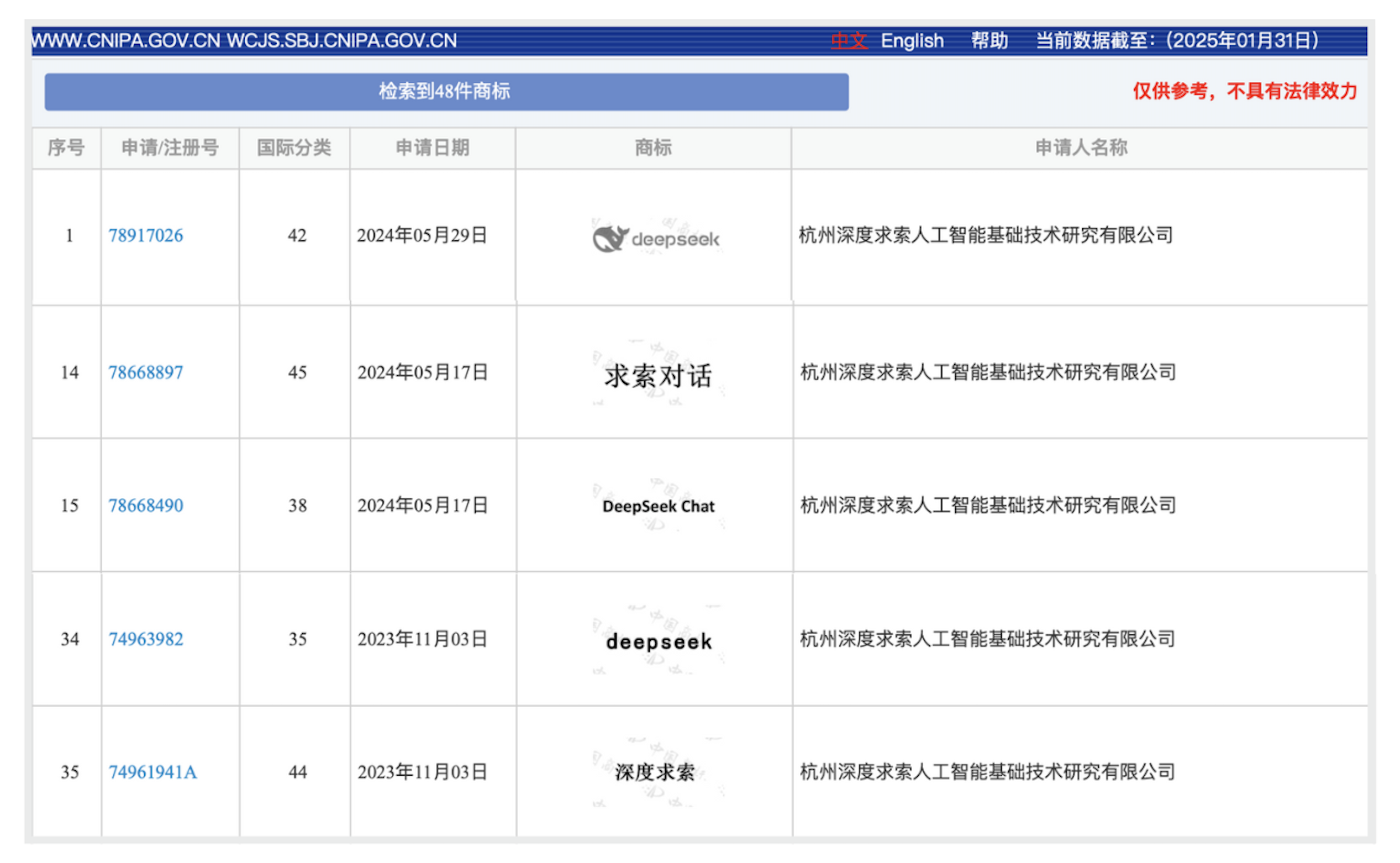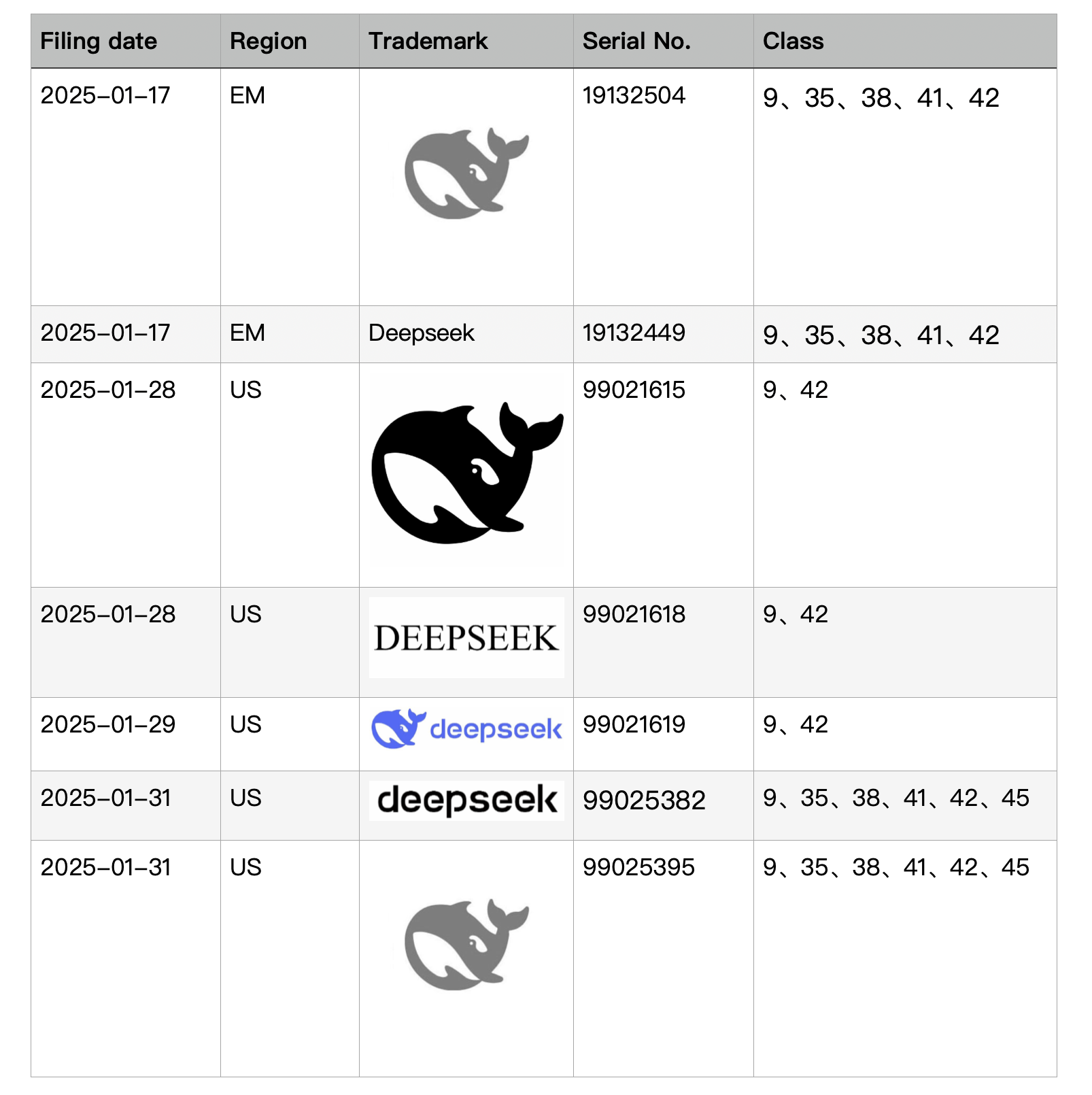January’s biggest news in the tech world is about DeepSeek. This multimodal AI model, developed by a Chinese company, took the international stage by storm, even causing ripples in the U.S. stock market. Founded in 2020, DeepSeek specializes in AI technology development and commercialization, offering products like AI models, data analysis tools, and industry solutions. With a strong technical team and collaborations with top universities (e.g., Zhejiang University, Stanford), DeepSeek has quickly expanded into major markets like the U.S., Europe, and Southeast Asia. But behind its rapid success lies a less glamorous reality: its delayed trademark strategy.
Public records show that DeepSeek began its intellectual property journey in 2021, focusing heavily on patents—a common move for R&D-driven companies. It wasn’t until late 2023 that trademark applications were on its schedule. According to data from China’s National Intellectual Property Administration (CNIPA), WIPO, and TMview, DeepSeek has filed nearly 50 trademark applications in China across 8 classes (9, 35, 36, 38, 41, 42, 44, 45), covering marks like “DeepSeek,” “DeepSeek Chat,” and “Qiusuo Dialogue.” Most have been successfully registered.

However, its global trademark strategy is still in its initial phase. As of January 30, DeepSeek has only filed applications in the EU and US (data for other countries may not yet be updated).
 There are already some existing applications in Australia, New Zealand, Canada, Turkey, the UK, Germany, and Japan may pose significant challenges, because most of them may likely be filed by squatters. DeepSeek attempted to address some of these issues by claiming the EM priority (January 17, 2025) for its US application, but it’s not enough. In China, earlier applications filed in early January in Classes 9, 35, and 42 owned by a Suzhou company still threaten its priority claims, and several companies have filed same trademarks in other classes, both of them are unrelated with the real master of DeepSeek. The similar trademarks are also be a problem for Deepseek in the examination, for example “Deepseeker” in Japan.
There are already some existing applications in Australia, New Zealand, Canada, Turkey, the UK, Germany, and Japan may pose significant challenges, because most of them may likely be filed by squatters. DeepSeek attempted to address some of these issues by claiming the EM priority (January 17, 2025) for its US application, but it’s not enough. In China, earlier applications filed in early January in Classes 9, 35, and 42 owned by a Suzhou company still threaten its priority claims, and several companies have filed same trademarks in other classes, both of them are unrelated with the real master of DeepSeek. The similar trademarks are also be a problem for Deepseek in the examination, for example “Deepseeker” in Japan.
DeepSeek’s story is a cautionary tale for startups and SMEs. Many entrepreneurs delay oversea trademark registration due to uncertainty of market and budget but not aware of the potential risk of the brand. Here’s how startups can avoid this trap:
1. Start Early: Trademarks First, Brand Second
Think Global: Conduct comprehensive trademark searches in target markets, manufacturing hubs, and competitor regions from day one.
Core + Defensive Classes: Beyond core classes (e.g., Class 9 for software, Class 42 for tech services), register related classes like 35 (advertising) and 45 (social services) to prevent “brand hijacking.”
2. Leverage International Systems
Madrid + Local Filings: Use the Madrid System for cost-effective registration in key markets, but file directly in high-risk or slow-processing countries.
Priority Rights: File applications in different country within 6 months of your first filing to maximize priority claims against squatters.
3. Monitor and Act Fast
Trademark Watch: Use tools like WIPO or TMview to monitor new applications and spot potential conflicts early.
Oppose or Negotiate: Challenge squatters through legal channels while exploring buyout options—some may settle for a low price.
4. Budget Smart, Plan Long-Term
Phased Registration: Align trademark filings with funding rounds and market expansion plans, prioritizing English-speaking and high-growth regions.
Cost Efficiency: Initial registration is the most cost-effective option. Post-registration disputes (e.g., cancellations, oppositions) can cost multiples more.
DeepSeek’s trademark journey underscores the critical link between IP strategy and business success. For startups, trademarks aren’t just legal assets—they’re your passport to global markets. By acting early, leveraging international systems, and staying vigilant, companies can protect their brand and secure a competitive edge.

